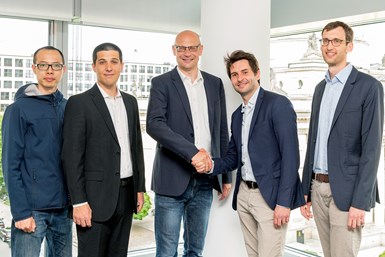Lithoz Acquires CerAMing
With the acquisition of CerAMing and its LSD printing technology, Lithoz says it now fully covers all strategically relevant market potentials in ceramic 3D printing.
The CerAMing team with Lithoz CEO, Dr. Johannes Homa. (left to right) COO Jinchun Chi, CTO Boris Agea Blanco, Lithoz CEO Dr. Johannes Homa, CEO/CFO Sebastian Walzel and Jörg Lüchtenborg. Photo Credit: Lithoz
Lithoz, a global market and technology provider in ceramic 3D printing, has acquired Germany-based CerAMing, the patent holder of the Layer-wise Slurry Disposition (LSD)-Print ceramic 3D printing process.
CerAMing is a spin-off of BAM (Bundesanstalt für Materialforschung und -prüfung/ German Federal Institute for Materials Research and Testing), having emerged from its Startup Slingshot program. With the acquisition of CerAMing, Lithoz now has a complete “all from one source portfolio” of complementary, market-relevant processes in 3D printing for advanced ceramics, with LSD-Print technology joining the LCM process and the LIS technology which was released in 2022.
The processes available from Lithoz have, up until now, focused on ultraprecise resolutions and highly complex internal structures in the case of LCM, and on particularly high wall thicknesses and large volumes with complete density in the case of LIS. The acquisition of the startup CerAMing and the associated expansion of the technology portfolio to include layer-by-layer slurry disposition mean that Lithoz now covers a very broad range of applications in ceramic additive manufacturing, with LSD-Print technology covering the area between the LCM and LIS process.
The company says all three processes share extremely high densities and excellent material properties of the printed objects. Depending on the specific strength of the respective technology, it is said even the most diverse of customer requirements can now be fulfilled from a single source.
“With the acquisition of CerAMing, Lithoz is expanding its technology portfolio through strategic acquisition for the first time,” says Dr. Johannes Homa, Lithoz found and CEO. “We see this technology as another key pillar in the realization of our vision to enable geographically independent, yet fully digitally connected global serial production in the ceramics industry.”
Related Content
-
Cranial Implant 3D Printed From Hydroxyapatite Ceramic: The Cool Parts Show #76
Cranial implants are typically made from titanium or PEEK; in this episode of The Cool Parts Show, we look at how implants made from a bioceramic can improve osseointegration and healing.
-
AM 101: What Is Binder Jetting? (Includes Video)
Binder jetting requires no support structures, is accurate and repeatable, and is said to eliminate dimensional distortion problems common in some high-heat 3D technologies. Here is a look at how binder jetting works and its benefits for additive manufacturing.
-
Stratasys and Desktop Metal to Combine in Approximately $1.8 Billion All-Stock Transaction
Merger looks to deliver industrial polymer, metal, sand and ceramic solutions from design to mass production.















